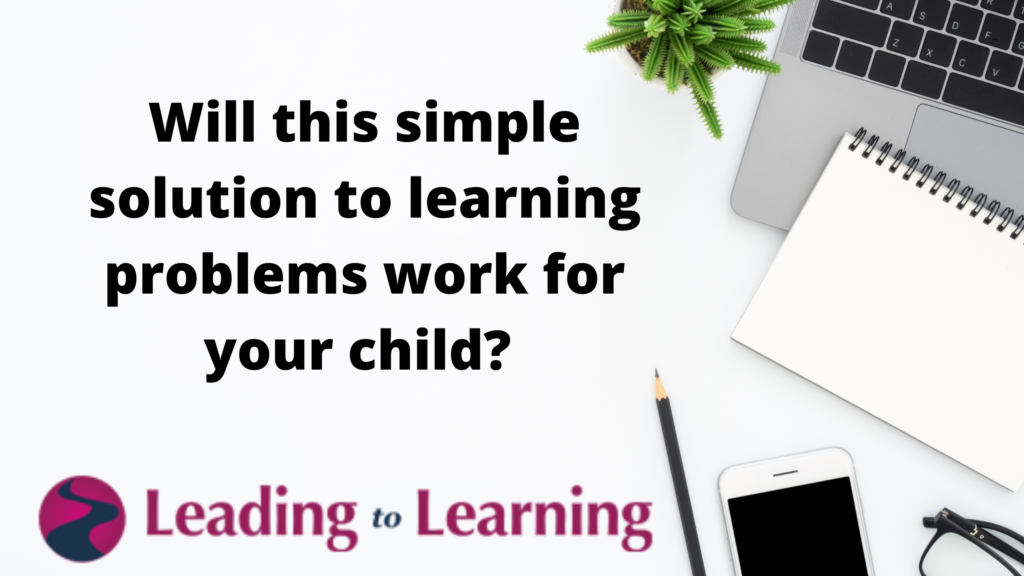I meet many students with different learning problems – but the all have the same simple solution. Could it be the solution to your child’s learning problems? Check out these three – true – stories and discover how easy it can be to overcome learning problems.
Story #1
Marianne was worried about her son. He didn’t seem to focus on anything. He was a bit of handful at home always on the move jumping from one thing to another never settling to something.. He chattered continuously and needed a lot of attention.
His teacher said that in class he found it difficult to sit still and had problems concentrating on his work. He wasn’t really a behaviour problem but he did annoy other students at times and she had no idea what he was learning in math because he never got his work finished.
He was in Grade 4 so something had to be done. His parents were looking for all the help they could get. Did he have ADD? Would talking to a behaviour therapist help? How could they help him focus on getting his schoolwork done?
What was his problem?
Story#2
Barry didn’t think the school was doing a good job of helping his daughter learn. She was in a remedial reading group – had been for a couple of years – and it didn’t seem to be working for her. He wondered if he should move her to a different school for Grade 5. He was dubious about getting a diagnostic learning assessment but didn’t know what else to do.
The assessment showed that his daughter was bright with good verbal skills and excellent visual skills. So why as she struggling to read?
A visit to the school provided the answer. The school used a well-known and respected reading program which was phonics based. His daughter struggled to learn to read in such a structured way but she wanted to do what the teachers asked her to do and as a result didn’t get good scores on reading tests.
How could she be helped?
Story #3
John was on the autism spectrum. He liked school and fitted in well with the rest of the class but he was struggling to keep up with the work he was expected to do. He would daydream in class and had trouble listening to his teacher. He worked well with his educational assistant and loved physical activity and drawing. His drawings were so detailed that it was obvious that he had great powers of observation. His parents weren’t willing to accept his diagnosis as an excuse for him not learning.
How could his teachers and his parents use his skills to overcome his communication difficulties?
Three stories – one solution!
These three children were examples of a problem that I have come to recognize, and almost expect, when parents tell me of bright kids who are struggling to learn. All three student had excellent learning skills – John’s verbal output was limited but his understanding was good. Despite the differences in their situations and all three children were struggling with the same issue. The way they were being taught did not match the way they liked to learn.
They were being taught in a Word Smart but they learned best in a Picture Smart way.
Let me explain.
Josh was a student in a French Immersion class. During his school day he had to listen to a language which was difficult for him to understand. He tried to learn French but found it frustrating. He was bored at school because he wasn’t being asked to use his skills to do his work. He loved, as was good at, picture puzzles and finding patterns in numbers. His teacher, quite rightly, concentrated on trying to get him to listen to her and, when he didn’t/couldn’t do that she assumed that he had problems focusing on the task at hand.
This bright child was so bored with having to listen all the time instead of being allowed to use his visual and deductive skills that he switched off. No wonder his parents thought he might have ADD.
Barry’s daughter was trying hard to do what the teacher wanted. But following a phonetic based reading program was causing her problems. She didn’t let herself use her vast visual skills to guess the words, she had to sound them out instead. Reading was hard work and she didn’t enjoy it.
When she was allowed to read for meaning and to guess the words she couldn’t read she started to read and enjoy chapter books. It took a while for her to gain confidence in her skills and to demonstrate that she could read given the chance to do it her way. Children live up to the expectations we put on them. Being placed in a remedial reading class made her think that she couldn’t read – so she didn’t!
John’s assistant was able to help John keep up in class. She ‘translated’ everything the teacher said into a visual of some kind. She showed John what to do rather than explain what he had to do. He was fortunate to have the help of an educational assistant who understood his needs. When his parents understood the type of help he needed they were able to help him learn.
Three problems – one simple solution
The more I work with parents who are concerned about tier child’s leaning the more I come across the same problem. Children who are visual learners – Picture Smart learners – struggle to reach their potential not because they can’t learn but because they are taught in Word Smart ways.
And the solution is simple. Picture Smart student need to be SHOWN what to do, not just told what to do. They need to be able to see the pattern and relationships in the problems they want to solve. They need to understand the context of what they are learning and, most of all, they need to trust their ability to work things out their own way.
A Picture Smart student might not now how he gets to the right answer. He might not understand all the steps that his brain is taking to ‘see’ the result. But that is OK. Later he will learn to stop jumping to conclusions and find ways to work though complex problems.
But, before he does that, he needs to develop the self-confidence to trust his instincts, to override logical ways of working, to grow into his skills and blossom.
If you have a Picture Smart learner and want to know how to help get in touch.
patricia@leadingtolearning.com
Everyone gets a free 30 minute call where we can discuss your concerns and consider next steps.
Picture Smart learners of the world unite! It is time to discover your potential.






